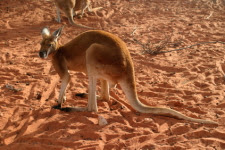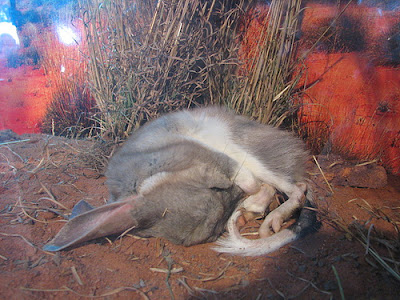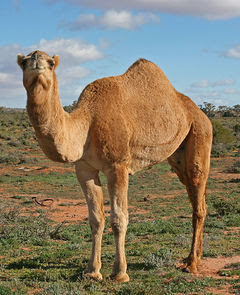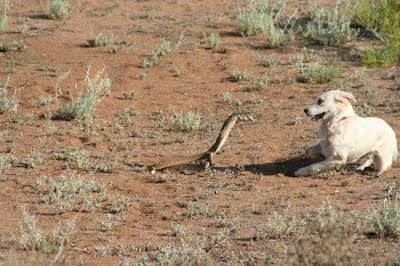|
|Mountain lion|
|A mountain lion swaggers across an outcropping in Arizona's Monument Valley. Unlike most other desert animals, mountain lions are active during the daytime|
|Currently, no more than several dozen in Algeria, Niger, and the Sudan remain in the wild. These beautiful antelope have been hunted to near extinction for their horns. Addax possess broad, flat hooves with flat soles that help prevent them from sinking into the desert sand! Addax will dig depressions in the sand in which to rest. These are often located partly underneath boulders that give shade and protection from the wind and sun|.jpg)
.jpg)
|Bilby information
|The pretty and delicate bilby once lived across most of the Australian inland deserts. Today its range is a lot more restricted (due to the usual environmental problems that we humans cause). Only small, fragmented populations survive in parts of the Tanami, the Gibson and the Great Sandy deserts.
Like most desert animals the bilby hides during the day and forages at night to avoid heat and dehydration. Bilbies dig burrows that are one to two metres below ground and moister and up to ten degrees cooler than the surface.
They are so efficient in conserving water that they don't need to drink. They get enough moisture from their food: seeds, bulbs, fungi, spiders and insects, which they find by scratching and digging. Just like the little fellow in the picture above.
|The pretty and delicate bilby once lived across most of the Australian inland deserts. Today its range is a lot more restricted (due to the usual environmental problems that we humans cause). Only small, fragmented populations survive in parts of the Tanami, the Gibson and the Great Sandy deserts.
Like most desert animals the bilby hides during the day and forages at night to avoid heat and dehydration. Bilbies dig burrows that are one to two metres below ground and moister and up to ten degrees cooler than the surface.
They are so efficient in conserving water that they don't need to drink. They get enough moisture from their food: seeds, bulbs, fungi, spiders and insects, which they find by scratching and digging. Just like the little fellow in the picture above.
Coyotes live in a hole or a den. Their den protects them from the heat and the wind. Coyotes eat almost anything. They hunt during the day or at night
Coyotes live in a hole or a den. Their den protects them from the heat and the wind. Coyotes eat almost anything. They hunt during the day or at night.
Coyotes live in a hole or a den. Their den protects them from the heat and the wind. Coyotes eat almost anything. They hunt during the day or at night
|camel information|
No, the camel is not a native Australian animal. But when camels were introduced they did so well that the camels that escaped or were let go by their owners multiplied rapidly and established a big and healthy population in the Australian Outback deserts. Today they are everywhere.
Australian deserts contain huge numbers of wild camels, camel meat is on the menu of many restaurants that offer "bush food", we have camel farms and camel rides are popular with tourists. We even export camels back to the countries they originally came from. Australia is one of the world's top producers of camels. No kidding.
Read more about camels in Australia, and the problems their exploding numbers are causing for the fragile Australian desert environment
Desert Animals
|desert tortoise information|
|The desert tortoise eats cactus, grasses, and wildflowers from March until June. They store fat and water in their bodies and dig holes to live in during the hot summers. They come out again in the
autumn when the weather is cooler.|
Emperor Penguins
|Sheltered by a titanic iceberg, emperor penguins bask in the Antarctic sun. Emperor penguins survive this harsh environment, where wind chills can reach -75 degrees Fahrenheit (-60 degrees Celsius), by huddling together in large groups to block wind and conserve
warmth|
.
| Herd of Goats|
|Goats manage to find edibles in the seemingly barren terrain of Australia's Simpson Desert. Many farmers raise livestock in the desert, but over-grazing can harm native species|
|Goats manage to find edibles in the seemingly barren terrain of Australia's Simpson Desert. Many farmers raise livestock in the desert, but over-grazing can harm native species|
|Gray fox|
|Lush fur and watchful eyes help this gray fox survive in the harsh, often cold climate of Chile's Atacama Desert, the driest place on Earth. Parts of this desert see rain about once every 10 years|
.jpg) |
|The dingo has lived in Australia for much longer than any other introduced animal. Still, it didn't evolve here. Dingos were introduced at least 3500 years ago.
The wild dogs had become an integral part of the Outback environment, but when white settlers arrived here, and brought their sheep, and there was a clash of interests, the hunter became the hunted.
Dingo numbers are steadily declining, so much so that dingos could become extinct within just a few decades. And that means we would be losing our best weapon in the fight against the most destructive feral predators and pests: cats, foxes and rabbits|
|Desert Dingo|
The dingo has lived in Australia for much longer than any other introduced animal. Still, it didn't evolve here. Dingos were introduced at least 3500 years ago.
The wild dogs had become an integral part of the Outback environment, but when white settlers arrived here, and brought their sheep, and there was a clash of interests, the hunter became the hunted.
Dingo numbers are steadily declining, so much so that dingos could become extinct within just a few decades. And that means we would be losing our best weapon in the fight against the most destructive feral predators and pests: cats, foxes and rabbits
| Meerkats|
|Watchful meerkats scout for predators outside their burrow in the South African Kalahari. If danger is spotted, they will alert others using a wide array of vocalizations, which some researchers think differ according to the type of threat|
|Gemsbok information|
|A gemsbok gallops through the loose sand of Namibia's Namib Desert. Considered one of the world's oldest deserts, the Namib contains sand dunes that reach some 1,000 feet (305 meters) in height|
| Perentie|
|The Perentie, a two meter monitor lizard that lives in the Australian deserts, uses the same strategy: it shelters in underground burrows.
Those burrows are huge and often have many escape tunnels. Not that the Perentie would need them. Perenties are amongst the top predators in the Australian deserts|
| Jackrabbit|
|Long ears alert for possible predators, a black-tailed jackrabbit rests near a cactus in the Arizona desert|


.jpg)
.jpg)

.jpg)
.jpg)
.jpg)
.png)
.jpg)

.jpg)
.png)
.jpg)
.jpg)
.jpg)
.jpg)
.jpg)
.jpg)
.jpg)
.jpg)

.jpg)
.jpg)
.jpg)
.jpg)

.jpg)
.gif)
.jpg)
.jpg)
.jpg)

.jpg)
.jpg)
.jpg)
.jpg)
.jpg)
.jpg)

.jpeg)
.jpeg)
.jpg)

.jpg)
.jpg)
.jpg)

.jpg)
.jpg)
.jpg)
.jpg)
.jpg)

.jpg)
.jpg)
.jpg)

.jpg)
.jpg)
.jpg)

.jpg)
.jpg)
.jpg)
.jpg)

.jpg)
.jpg)
.jpg)
.jpg)
.jpg)

.jpg)
.jpg)
.jpg)
.jpg)
.jpg)







.jpg)
0 Comments